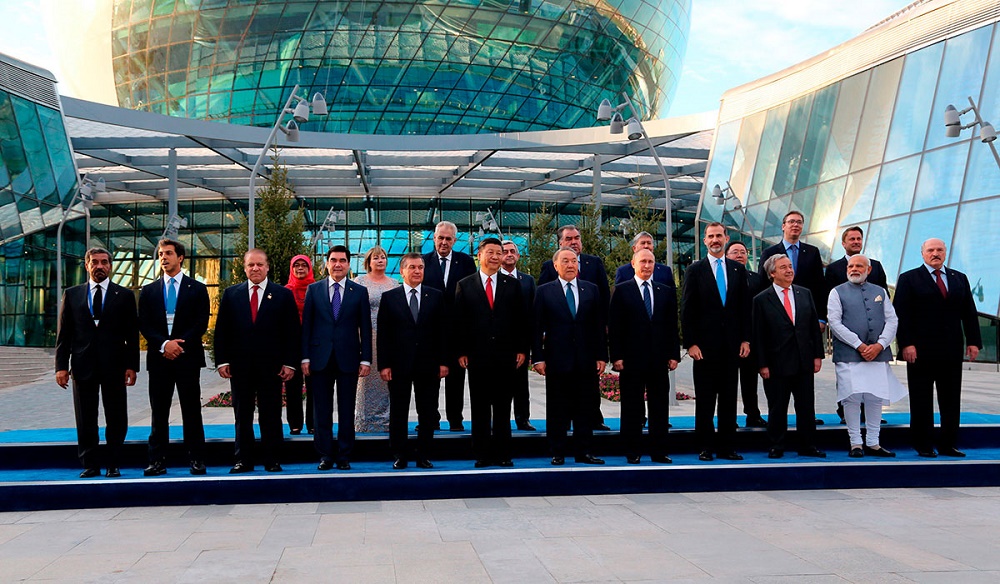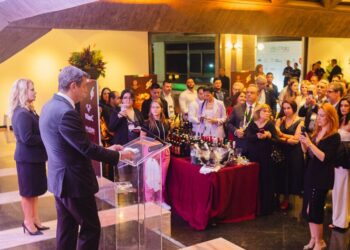

For 25-year-old Kazakhstan, the expo is the most important event in its history. Kazakhstan has hosted large-scale events like the Organisation for Security and Co-operation in Europe (OSCE) summit in 2010 and the winter Asian Games in 2011, but the expo supersedes all the others in its magnitude. Indeed, it is “a new peak in the promotion of our country and national brand ‘Kazakhstan’ in the global space,” the President said. “Declaring theme ‘Future Energy,’ we intend to be in the very core of scientific progress.” Despite Kazakhstan’s massive hydrocarbon reserves, the country will actively switch to renewable energy sources, Nazarbayev explained.
“By 2050, Kazakhstan can produce half of the total electricity through renewable sources. At the same time, the economy’s energy intensity will be reduced.” Nazarbayev also described how the expo infrastructure will be used after the event, including housing the Astana International Financial Centre, the International Centre for Development of Green Technologies and Investments, and an International Technology Park of IT Start-ups. “Thus, the EXPO’s ‘pulse of innovation’ will keep on beating for the benefit of the country, the region and the world.” The June 9 opening concert and fireworks show went late into the night.
The next day the expo launched with displays of African jazz, Russian stilt walkers and Asian dancers, to name just a few of the many cultural presentations in the expo zone. Kazakhstan’s pavilion, a huge sphere, tells the story of the young country, including its ancient history, through art installations, enigmatic 3D shows and video clips unveiling future energy. Each pavilion offers a unique concept about future energy, an idea
each country interprets in a different way. The US pavilion sees it as the source of infinite energy that’s within all of us. “It’s imagination, innovation; it’s invention that has driven America and that drives other countries that we see here gathered in Astana for EXPO 2017,” pavilion director of communications Anthony DeAngelo told The Astana Times. “We are focused on the power that lies within all of us as individuals, as nations, to power the future,” he added. The Russian pavilion, focusing on the Arctic, nuclear power and renewable energy sources, features a real iceberg brought from the Arctic. “This iceberg is over four metres in height,” said Russian pavilion guide Aigul. “This is only a small fragment transported in a container and it was broken off by a Russian icebreaker ship.
With the help of such icebreakers like the Russian Leader that will be finished in 2025, Russians want to research the Arctic.” Dozens of heads of state arrived in Kazakhstan for the expo opening, among them King of Spain Felipe VI on his first official visit. “It is a great honour for me that my visit is taking place during the unique opening ceremony of EXPO 2017 in Astana. I congratulate you on this great event,” Felipe VI told Nazarbayev in their bilateral meeting. President of the Czech Republic Milos Zeman was also on hand for the opening. “I remember well your visit to Kazakhstan in 2014,” Nazarbayev recalled. “Since that time much has been done between our countries, and development of bilateral relations both from a political perspective and in the economic domain are positive.
Cazaquistão festeja abertura da Expo Astana 2017



A abertura contou também co Também não faltaram apresentações musicais, com músicas e danças tradicionais do Cazaquistão. “Seis mil eventos culturais serão realizados dentro da Expo. Os visitantes poderão aprender sobre a cultura e a história do povo cazaqu Cazaquistão, Quirguistão, Uzbequistão, Tadjiquistão, Paquistão e Índia, estiveram presentes na abertura da exposição. Os convidados visitaram o pavilhão Nur Alem, a maior construção esférica do mundo, com 80 metros de diâmetro, q metros de diâmetro, que é símbolo desta Expo. A abertura contou também com um espetáculo multimídia no Centro de Congressos da capital, onde robôs e pessoas dividiram o palco em uma apresentação cuja temática foi a energia, sob u energia, sob uma estética contemporânea.
Também não faltaram apresentações musicais, com músicas e danças tradicionais do Cazaquistão. “Seis mil eventos culturais serão realizados dentro da Expo. Os visitantes poderão aprender sobre a cultura e a história do povo cazaque, e também visitar outros cantos do Cazaquistão”, disse Nazarbayev. Entre eles se encontram 71 números do Cirque du Soleil, desenvolvidos especialmente para a Expo, e apresentações de P e Plácido Domingo, Steve Aoki, Eros Ramazzotti e Afrojack, entre outros. Espera-se que a exposição internacional atraia entre dois e cinco milhões de visitantes. Por isso, vários hotéis foram construídos, com capacidade para 35 mil pessoas, entre eles o luxuoso Hotel Ritz-Carlton, inaugurado em 4 de junho, e residências para 40 mil estudantes, e também foram feitas melhorias no sistema de transportes.
O Cazaquistão também construiu um novo megaterminal no aeroporto Internacional de Astana por causa do evento internacional, que aumentará sua capacidade de 3,6 milhões para 8,2 milhões de passageiros por ano. Além disso, o país centro-asiático fechou diferentes acordos bilaterais e multilaterais de “céus abertos” durante os três meses de duração da Expo 2017 e flexibilizou o regime de vistos para dezenas de países.
O evento, cujo foco está nas energias renováveis e que contará com a participação de 115 países e 22 organizações internacionais, é considerado um marco na presidência de Nazarbayev. A Expo Astana 2017 pretende trazer reflexões sobre a importância de se avançar para um sistema energético mundial baseado cada vez mais em energias renováveis, que ajudem a reduzir as emissões de CO2 e a dependência do petróleo e aumentem a autonomia energética das diferentes regiões e comunidades do mundo.















